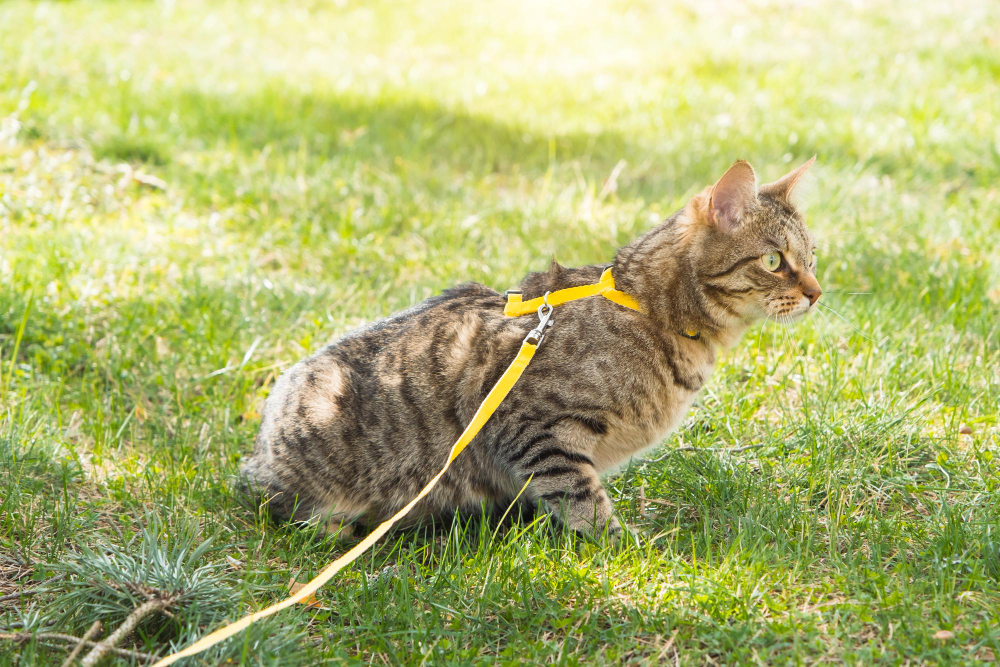Cats are notorious for refusing to walk on a leash. Training your cat to wear a harness, on the other hand, may be easier than you think. Harness training your cat has more advantages than just being handy for pet owners. Do you know how to walk a cat? Then, you may take your cat for a safe and enjoyable walk with the correct harness. Cat harnesses are composed of woven cloth that is both strong and flexible. Because it reaches down your pet’s chest, wrapping around the neck and torso, behind the front legs, a harness is more secure than a collar. Allow your pet cats to come and go outside as they like if you have them. Cats like exploring and this independence may be appreciated by your cat. Free-roaming, on the other hand, is not safe for your cat for the following reasons:
- They could be struck by an automobile.
- They may be pursued and harmed by predatory animals.
- They’re more prone to get ill.
- It’s possible that stalking and eating tiny animals will result in parasites or illness.
Depending on where you reside, free-roaming may even be prohibited. Many municipalities have ordinances prohibiting cats from roaming freely without being harnessed and leashed. Training cats to walk on a leash is feasible, even if they are not as responsive as dogs. Your cat may like wearing a harness over time since it allows them to roam outside while being supervised.
Is It Okay to Leave Your Cat in A Harness?
Before working on leash training, your cat should be comfortable wearing a harness for 10 to 15 minutes. Begin at a peaceful, secure location. Connect the harness to a six- to eight-foot lightweight leash (never link a leash to the cat’s collar). Give your cat a treat once you’ve waited patiently until there’s no tension on the leash. Allow him to move about with the leash as long as he is not tugging. Follow him to avoid stress on the leash.
Keep the following in mind:
- Never leave a cat on a harness unattended.
- Associate the harness with enjoyable activities like play, food, or treats.
- Begin with a brief session – no more than two minutes or ten rewards.
- Wait a while; your cat will gradually accept the harness.
Can A Harness Hurt a Cat?
Walking your cat outside is a terrific method to keep them mentally and physically stimulated. However, before your cat goes exploring the vast outside, you need to acquire them a safety harness.
Because there is no way for a cat to get out of a harness, it is more secure than using a collar and leash. Cats, on the other hand, can slip out of a collar in no time. In addition, a collar and leash might damage a cat’s throat if it is highly squirmy.
There are three types of cat harnesses, all of which will keep your cat safe. You may select a fun color or pattern once you’ve decided on the perfect design for your pet. Choose one composed of a soft material that will be comfy for your cat.
How Tight Should a Cat Harness Be?
A cat’s harness should be sufficiently secured, but not too stiff on the neck, so there’s enough tension, but the cat doesn’t choke on the harness.
It’s not simple to put a harness on a cat, especially if it’s a feisty feline. This is why experts advocate acclimating them to a harness while your cat is still a kitten. But don’t panic if you have an older cat; it’s never too late to introduce your cat to a harness, especially if they are receptive to new experiences. Continue reading to learn how to train your cat to wear a harness.
Read the instructions that came with your harness to get ready. Your cat will be fidgety at first, so think about how you might help them feel more at ease.
To put your cat’s walking harness on, follow these steps:
- Allow your cat to investigate the harness by leaving it out. Placing it in a familiar location, like their favorite sleeping or eating position, might help them overcome their anxiety about the strange thing.
- Slip the harness over your cat’s head when you think they’re ready.
- If the harness is an H-type or a figure-eight design, secure the neck-straps first, then the middle strap, and, if there is one, the back strap. Next, place a vest harness on your cat’s back and attach the neck and midsection clips if you have one.
- To begin, practice walking with the harness at home. Allow them to become accustomed to it as part of their natural environment.
It can be helpful to have some assistance the first time you try to put the harness on your cat. You can assist in putting the harness on your cat while one person holds it.
If your cat attempts to wiggle away or claws and bites at you, it’s a good clue they don’t enjoy it. You don’t want to worry your cat since this might lead to additional issues in their lives, such as peeing outside the litter box. You don’t want to put them in a stressful situation before they embark on an outdoor expedition.
How Long Does It Take for A Cat to Get Used to A Harness?
Many cats require several weeks (or even months) to become accustomed to wearing a harness. The consistency and patience with which you educate your dog to walk on a leash determine whether you are successful.
When your cat is still a kitten, it’s typically easier to begin leash training. That doesn’t imply that elderly cats can’t be trained to walk on a leash. It helps if they’re confident cats who aren’t afraid of new things, trust you, and are food driven. Leash training isn’t impossible in most circumstances; it simply requires knowledge and patience.














